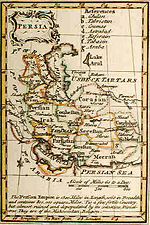Zand dynasty

|
|||||||||||||||||||||||||||
 |
||||||||||||||||||||||||||||||||||||||||||||||||||||||||||||||||||||||||||||||||||||||||||||||||
|
||||||||||||||||||||||||||||||||||||||||||||||||||||||||||||||||||||||||||||||||||||||||||||||||
The Zand dynasty (Zand) (سلسله زندیه) ruled southern and central Iran (1750–1794) in the eighteenth century.
Contents |
History

Karim Khan Zand


The dynasty was founded by Karim Khan, chief of the Zand tribe. He became one of Nadir Shah's generals.[1] Nadershah moved the Zand tribe from their home in Lorestan to the eastern steppes of Khorasan. After Nader’s death, the Zand tribe, under the guidance of Karim Khan, went back to their original land.[2] After Adil Shah was made king Karim Khan and his soldiers defected from the army and along with Ali Morad Khan Bakhtiari and Abolfath Khan Haft Lang, two other local chiefs, became a major contender but was challenged by several adversaries.[3] Abolfath Khan was the Prime Minister, Karim Khan became the army chief commander and Ali Morad Khan became the regent.[3] Karim Khan declared Shiraz his capital. He gained control of central and southern parts of Iran. In order to add legitimacy to his claim, Karim Khan placed the infant Shah Ismail III, the grandson of the last Safavid king in 1757 on the throne. Ismail was a figurehead king and real power being vested in Karim Khan. Karim Khan chose to be the military commander and Alimardan Khan was the civil administrator. Soon enough Karim Khan managed to eliminate his partner as well as the puppet king and in 1760, founded his own dynasty. He refused to accept the title of the king and instead named himself The Advocate of the People.
By 1760 Karim Khan had defeated all his rivals and controlled all of Iran except Khorasan, in the northeast, which was ruled by Shah Rukh. His foreign campaigns against Azad Khan in Azerbaijan and against the Ottomans in Mesopotamia brought Azerbaijan and the province of Basra into his control. But he never stopped his campaigns against his arch-enemey, Mohammad Hassan Khan Qajar, the chief of the Quvanlu Qajars. The latter was finally defeated by Karim Khan and his sons, Agha Mohammad Khan and Hosseingholi Khan, were brought to Shiraz as hostages.
Karim Khan's monuments in Shiraz include the famous Arg of Karim Khan, Vakil Bazaar, and several mosques and gardens. He is also responsible for building of a palace in the town of Tehran, the future capital of the Qajar dynasty.
Decline and Fall
Karim Khan's death in 1779 left his territory vulnerable to threats from his enemies. His son and successor Abu al-Fath was an incompetent ruler who was heavily influenced by his half uncle (and Karim Khan's commander), Zaki Khan. Other rulers such as Ali Morad and Jafar Khan also failed to follow the policies of Karim Khan and soon enough, the country was under attack from all sides.
The biggest enemies of the Zands, the Qajar chiefs, lead by the former hostage, Agha Mohammad Khan, were advancing fast against the declining kingdom. Finally, in 1789, Lotf Ali Khan, a grand-nephew of Karim Khan, declared himself the new king. His reign (until 1794) was spent mostly in war with the Qajar khan. He was finally captured and brutally killed in the fortress of Bam, putting an effective end to the Zand Dynasty.
Politically, it is also important that the Zands, especially Karim Khan, chose to call themselves Vakilol Ro'aya (Advocate of the People) instead of kings. Other than the obvious propaganda value of the title, it can be a reflection of the popular demands of the time, expecting rulers with popular leanings instead of absolute monarchs who were totally detached from the population, like the earlier Safavids.
After the Islamic Revolution of 1979 the Zand was the only dynasty whose names on public places and monuments were not removed by the new Republican government.
Culture

The Zand era was an era of relative peace and economic growth for the country. Many territories that were captured by the Ottomans in the late Safavid times were taken back and Iran was once again a coherent and prosperous country. After Iranian painting reached its height at the end of the 17th century, a special school of painting took shape during the Zand era in the 17th and 18th centuries.[4] The art of this era is remarkable and despite the short length of the dynasty, a distinct Zand art had the time to emerge. Many Qajar artistic traits were copied from the Zand examples.
In foreign policy, Karim Khan attempted to revive the Safavid era trade by allowing the British to establish a trading post in the port of Bushehr. This opened the hands of the British East India company in Iran and increased their influence in the country.[5] The taxation system was reorganized in a way that taxes were levied fairly. The judicial system was fair and generally humane. Capital punishment was rarely implemented.[6]
Kings of the Zand dynasty
- Karim Khan, 1750–1779
- Abol Fath Khan, 1779
- Ali Murad Khan, 1779
- Mohammad Ali Khan, 1779
- Sadiq Khan, 1779–1782
- Ali Murad Khan, 1782–1785
- Jafar Khan, 1785–1789
- Lotf Ali Khan, 1789–1794
External links
- http://www.iranchamber.com/history/zand/zand.php
- http://www.iranologie.com/history/history13.html
- http://www.friesian.com/iran.htm#zand
See also
- History of Iran
- List of kings of Persia
